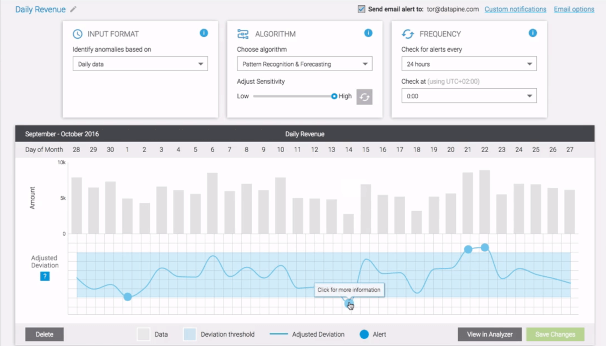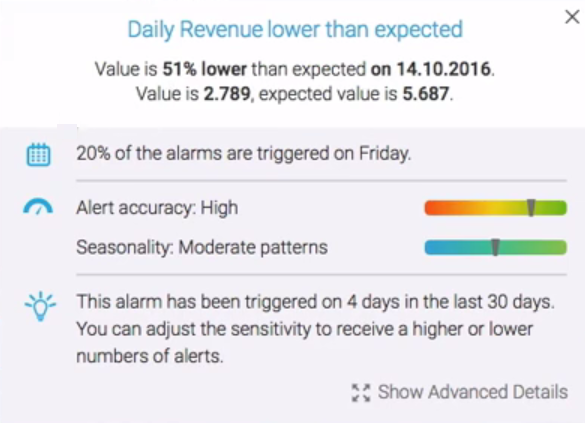How Artificial Intelligence Takes Business Intelligence Tools To The Next Level

Artificial intelligence (AI) is here and it is getting smarter all the time. For many, mention of AI immediately conjures up images of The Terminator. At the very least it makes many think of robots and machines disrupting the workforce and replacing jobs. While the latter may not be completely out of the realm of possibility, datapine is leaving that side of AI to Silicon Valley and John Connor. Instead we are excitedly monitoring and utilizing artificial intelligence in business intelligence.
We offer a 14-days free trial including powerful AI features!
The History and Explosion of Artificial Intelligence
At the basic level, artificial intelligence is computer-based systems that eventually learn and adapt for themselves. In other words, it is the broad concept of machines being able to carry out tasks in a way that humans consider “smart.”
The concept isn’t new: Greek myths contain stories of mechanical men designed to mimic human behavior. The term and science isn’t new either: one of the first AI research efforts occurred over 60 years ago at Dartmouth College. While artificial intelligence's history is long, the last couple years have seen exponential growth and investment in the AI space.
With the expansion of AI has come various new terms and categories. Nowadays devices that act intelligently are often placed into two AI groups- applied or general AI. Applied AI is the most common type. Applied AI systems are designed to perform tasks like intelligently trade stocks or drive autonomous vehicles.
The second type falls under generalized AI. In theory, these systems and devices can handle any task. Generalized AIs are getting all the buzz these days, especially in regards to the development of machine learning, considered as the next wave of AI. While artificial intelligence is a branch of computer science working to build machines capable of intelligent behaviour, Stanford University defines machine learning as “the science of getting computers to act without being explicitly programmed”. The growing theory is you need AI specialists to build smart machines and machine learning experts to make them truly intelligent. All of this is being assisted by the growth of neural networks, which are computer systems designed to work by classifying information in the same way a human brain does. Neural networks and natural language processing are facilitating advanced systems that understand, learn, predict, adapt and potentially operate autonomously.
The tech and investment sectors are taking note. Artificial intelligence in tech was particularly hot in 2016. Google, Facebook, Apple and Microsoft all launched dozens of AI powered products and services powered. Some other recent launches and 2016 headlines include:
- Minecraft, a popular video game owned by Microsoft, started allowing computer scientists and amateurs to evaluate and develop AI software using its virtual landscapes in July
- Amazon Web Services launched an artificial intelligence service.
- Salesforce introduced Salesforce Einstein: an AI system that analyzes data to identify marketing and sales trends.
- AI’s benefits are being felt across departments: A recent survey by Demandbase found that “80 Percent of all Marketing Executives Predict Artificial Intelligence Will Revolutionize Marketing by 2020”
- And in a headline that really grabbed our BI attention: Gartner named AI & Advanced Machine Learning the number one trend in its Top 10 Strategic Technology Trends for 2017.
This list only provides a snippet of what has happened in artificial intelligence so far. And there is so much more on the horizon.
Business Intelligence and Artificial Intelligence: The Perfect Match

Advanced machine learning and Artificial intelligence are exciting and definitely disruptive. No doubt we will feel the effects throughout our business and personal lives. These advances will be particularly revolutionary for artificial intelligence in business intelligence. Historically, BI tools’ bread and butter has been answering the “what happened” questions. Interactive dashboards and the ability to dig into the data to see “why it happened” made BI essential. Initially just gaining access to this business data and being able to answer the “what and why” questions was enough to transform the business office. Increasingly this isn’t enough.
To compete in progressively complicated markets, organizations are now looking to answer the “what will happen next” questions. Sameer Anand, Partner in A.T. Kearney Inc.’s operations practice has been watching this trend “What we see is companies are thinking about predictive and foresight, and that’s where I think this is going to be more AI and not BI.” Businesses are turning to business analytics that provide real-time dashboards that have integrated intelligent alerts. Most innovative BI features like this are being powered by artificial intelligence: welcome to the world of AI BI.
These modern BI software now help monitor your most important metrics and informs. Even better they automatically alert users as soon as an unexpected event happens or a predefined goal is met. Innovative business dashboards utilize underlying algorithms based on artificial intelligence. These algorithms continuously learn from historical trends and patterns in the data sets. All of this allows anomalies, especially in data sets with high seasonality to be identified with high accuracy.
All of this makes BI and AI a perfect match. Historically, BI has been a largely descriptive and diagnostic activity with the end goal of understanding historical performance. To this end, manual, time consuming, and expensive processes are often performed to produce reports/dashboards. Then costly time is spent looking at tables and data visualizations to gain insights and unearth trends and issues. This is where artificial intelligence comes into play. When a process is manual, time-consuming, and expensive, it is ripe for the application of artificial intelligence. Through AI, business intelligence platforms move beyond descriptive and diagnostic analysis towards automated analysis that highlights significant facts and hypotheses within the data.
How Artificial Intelligence Refines Alerts in Business Intelligence Tools
One of the best ways to integrate AI BI is through artificial intelligence powered alerts embedded in real time dashboards. There are many different types of alerts in BI tools. Let's take a closer look at 3 types you can find in datapine.
The first alert type are threshold alerts. These basic alerts allow users to define an absolute or relative range in which the tracked KPI can fall without launching an alert. Once the measured value falls outside the predefined thresholds that the selected users will be immediately notified. This allows businesses to take swift action and stay ahead of any issues. The threshold alert can be further segmented into:
- Absolute Value Alerts: triggered when an observed value falls below or exceeds a defined absolute value. This is useful for notifying when certain targets, such as your sales quota, are reached.
- Relative Value Alerts: triggered when a percentage difference of the observed value to its previous value falls below or exceeds a defined range. This is great for when you want to track the number of visitors on your website. For example, the relative value alert will inform users when there have been 50% less visitors on your website today compared to yesterday. An alert like this could point you to a possible website issue that is deterring traffic. Once again, an alert like this allows businesses to stay ahead of issues that can affect their bottom line.
Another alert is the pattern recognition alert. This machine-learning algorithm based alert is more advanced than threshold alerts. A setup in datapine looks like in the example below.

Here an algorithm applies pattern recognition and forecasting techniques to predict the next expected value of a data series. Strong patterns found in the underlying data help generate accurate and useful predictions. Pattern recognition alerts predict the value of the next period based on historical data and then compare this expected value to the real outcome. Once an alert is triggered you get valuable information like in the example below.

Our most advanced alert is the neural network alert. This is the closest thing to an alert acting like a human brain, a very smart human brain. At datapine our neural network alert is powered by an artificial-intelligence algorithm based on some of the most advanced neural networks used in the field of anomaly detection. The algorithm models some of the structural and algorithmic properties of the neocortex. Additionally, it combines and extends approaches used in Sparse distribution memory, Bayesian networks and spatial and temporal clustering algorithms. All of this is done while using a tree-shaped hierarchy of nodes that is common in neural networks. With a model like this modern BI tools can predict the next value based on historical patterns and then measures the difference between the predicted value and the next actual value. The higher the deviation, the higher the degree of anomaly. Additionally, the alert provides a measure of certainty called a fluctuation margin. The fluctuation margin attaches a measure of confidence to the output to help you gauge what action to take or not to take.
We offer a 14-days free trial including powerful AI features!
The Future is Now
Artificial intelligence in business intelligence is witnessed through AI-powered alerts, from basic threshold-alerts to advanced neural network alerts, and helps businesses stay in full control of key success factors by alarming them as soon as something happens. What is even more exciting, we are only at the cusp of what artificial intelligence and advanced machine learning can do. When combined with innovative business dashboards these AI advances will continue to revolutionize the business intelligence landscape. All of this allows businesses to step away the time intensive process of digging through data to unearth trends and reacting to already costly issues.